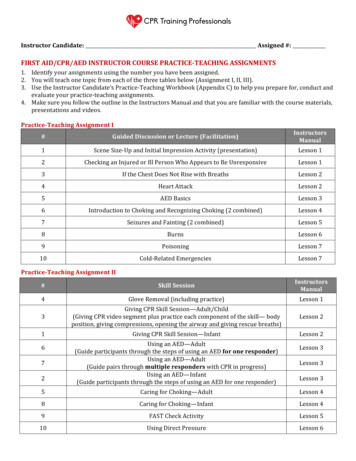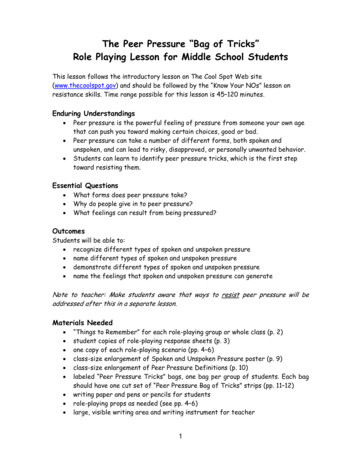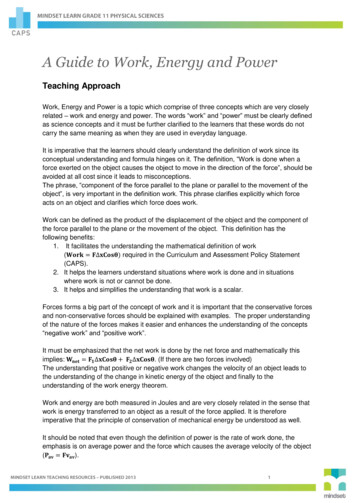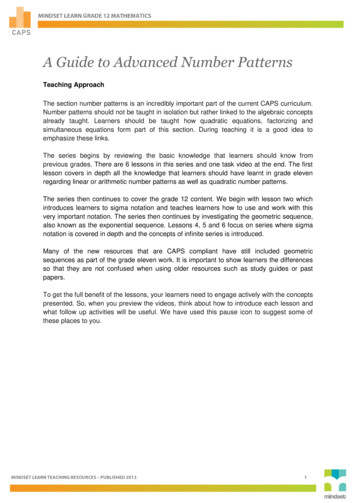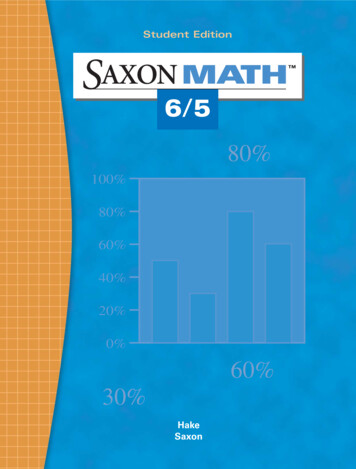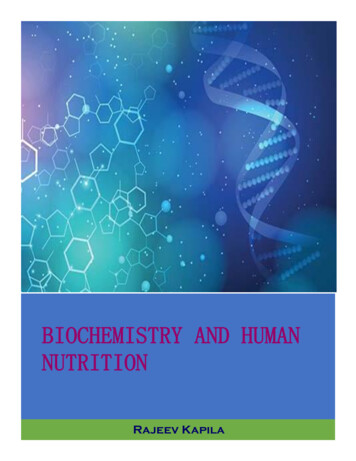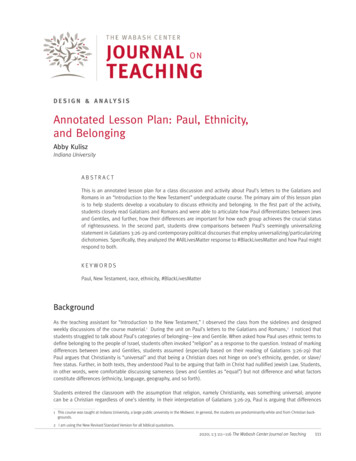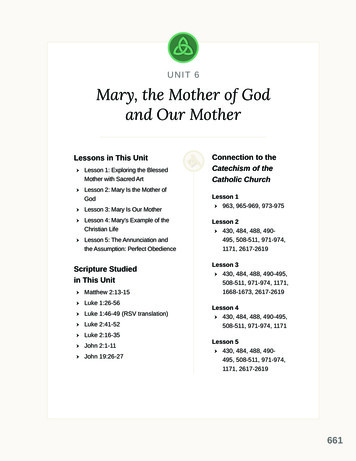
Transcription
Lesson Plan Resources2-Column Note3-2-13-Column Note5W & How Organizer5W ModelABC OrganizerAcrosticsAnalyzing PerspectiveAnticipation GuideAssessment PromptsBlogBrainstorm GraphicOrganizerCategorize VocabularyTeaching StrategySee attached Graphic OrganizerSummarizing Strategy See belowTeaching StrategySee attached Graphic OrganizerTeaching StrategySee attached Graphic OrganizerTeaching StrategySee attached Graphic OrganizerActivating/Vocabulary See attached Graphic OrganizerTeaching StrategyMake up a sentence using the first letter of each word,sequencing, listsExample for order of operations in math:Please Excuse My Dear Aunt SallyTeaching Strategy/Extended ThinkingSee attached Graphic OrganizerActivating StrategyIt is a list of statements (not questions) that are related to thereading selection. The statements are not taken directly fromthe selection, but are inferential so that the students have toreally read the selection and think about it. The students thendecide whether they agree with each statement or disagreewith it. One variation is that the students have to give prooffrom the selection to back up their opinions. Some of thestatements should be written so that students can agree ordisagree depending on how they interpret the information inthe reading selection. This will encourage discussion.(see example below)Formative assessment used to gather evidence of learning atstrategic points throughout the lesson, which helps the teacheradjust instruction to meet the needs of the learners. They canbe in many formats:Written: Think-Ink-Share, Quick Write, Journal Response,Carousel brainstorm, RAFT, Math problems, Error AnalysisVisual: Draw a diagram/sketch, Create a visual symbol,Complete a graphic organizer, Think-Sketch-ShareOral: Think-Pair-Share, Numbered Heads TogetherShow Me: Word sort, Classify items, Mini-whiteboard response,ABCD cards, DemonstrateSummarizing StrategyA creative format that allows students to summarize learnedmaterial.Activating or Teaching StrategySee attached Graphic OrganizerActivating Strategy1.Introduce new topic2.Have students brainstorm ideas that they already know aboutthe topic. You can use sticky notes or slips of paper for ideasfrom students.3.After going over all their ideas, help them come up withcategories on the board and have students put their ideasunder the appropriate category (sticky notes under or tape theslips under the correct category.)4.Diagram what they have accomplished on chartpaper/whiteboard/Smart Board. As you work through the
Cause/EffectCharacter ept Definition MapConcept MapConstructing SupportCreative DesignCycle GraphDeductive ReasoningDescriptive OrganizerError AnalysisExplanationExplanation/processField Notes & RecordFishbone DiagramFlow chartFRAMEFrayerIllustrationInductive ReasoningInterpretationlesson and learn new material, students can add morecategories, ideas, and maybe revise previous information.Teaching StrategySee attached Graphic OrganizerTeaching StrategySee attached Graphic OrganizerActivating Strategy1.Introduce new topic2.In groups, pairs, or individually use blank paper/graphicaloutline/diagram/chart of topic3.Students draw, fill in outline/diagram/chart, or creatediagram of the topic4.Students share their information5.Save this information so it can be revised or referred toduring the lessonEx: Diagram the inside of a cell, create a chart that representsthe data setGrouping items into definable categories on the basis of theirattributes (Extended Thinking)See attached Graphic OrganizerSee attached Graphic Organizer (Extended Thinking)Activating/Vocabulary StrategySee attached Graphic OrganizerSee attached Graphic OrganizerSee attached Graphic OrganizerTeaching StrategyStudents create a model/representation of the learningthroughout the learning experience. With themodel/representation complete, the student summarizes theprocess or learning.See attached Graphic OrganizerSee attached Graphic Organizer (Extended Thinking)See attached Graphic OrganizerSee attached Graphic Organizer (Extended Thinking)Summarize learningSummarize learning based on the process or sequenceObserve and record data based on observation and/orevaluation of material then summarize findings beforeprogressing to the next level/stepTeaching Strategy—Cause/EffectSee attached Graphic OrganizerSee attached Graphic OrganizerSee attached Graphic OrganizerActivating/vocabulary StrategySee attached Vocabulary Graphic OrganizerDraw a picture that is a visual representation of the topic. Thisallows the student to conceptualize the topic and demonstrateunderstanding.See attached Graphic Organizer (Extended Thinking)Summarization strategyThis allows the student to write a journal or learning log entrybased on his or her translation of the text, picture, musicalpiece, etc.
Journal/Journal EntryJustify Your AnswerK-W-LK-W-L PlusLabel & RecordLearning/Reflection LogMain idea and Detail mapMain Idea MapMain Idea SummaryMatrixMind MapModelObservation OrganizerOne Sentence SummarySummarizing StrategyA written summary that reflects learning, misconceptions, andquestions, and this journal can help the teacher know if sheneeds to review or move forward with the lesson.See attached Graphic OrganizerActivating StrategyThis strategy helps students make connections to what theyknow, what they want to learn, and new information they learnabout a topic. It’s a brainstorm tool to gather prior knowledge,preview new information and vocabulary, and recallinformation after learning it.See attached Graphic OrganizerActivating StrategyThis KWL has an added feature that allows the students tocategorize their learning along with summarizing their learning.See attached Graphic OrganizerActivating/Teaching StrategyStudents predict where target vocabulary is placed within adiagram or to label a model then explain their placement ofeach word. As the lesson progresses the student makesrevisions and explains the change.OrDuring the lesson, each students labels the diagram/modelrecording their learning with specific details from the lecture,text, video, etc.Summarizing StrategyA written summary that reflects learning, misconceptions, andquestions, and this journal can help the teacher know if sheneeds to re-teach or move forward with the lesson.1.During the last 5-8 minutes of the class, students respond inwriting to a set of questions2.They could explain how to do a skill, operation, summarizethe lesson, describe an event/place, explain important/mainidea, or respond to questions.3.Sometimes the log can be verbal and shared with a partnerthen recorded in the learning logSee attached Graphic OrganizerSee attached Graphic OrganizerSee attached Graphic OrganizerSee attached Graphic OrganizerTeaching StrategyAllows the learner to organize mental maps with priorknowledge and new information using words, symbols, picturesthat include main ideas, details, categories, parts, diagrams,etc.During the lesson, each students labels the model recordingtheir learning with specific details from the lecture, text, video,etc.See attached Graphic OrganizerSummarizing StrategyEx: During the science experiment, I, and my hypothesisabout the experiment .
Paragraph SummaryPattern AnalysisPerformPortfolio Page/Log/EntryPrediction GuideProblem Solving MapProblem/SolutionQuestion Quiz ShowRAFTRead AloudReflective JournalRephraseRole PlaySequence MapSQ3RSQ4RSteps in a ProcessStory MapStory PyramidStudy CardsStudents use details from graphic organizer or class notes towrite a summary in their own wordsFind, identify, and explain patterns within specificskills/concepts/situationsSummarizing StrategyStudents display learning based on a role play, dramaticportrayal, musical rendition, etc.Examples of student learningActivating StrategyUsed to assess students background knowledge about a topic.Students answer questions that relate to the main conceptswithin text. This strategy allows a student to read a text withgreater focus because they are actively engaged looking forevidence to prove their predictions. (Like Anticipation Guide)See attached Graphic OrganizerSee attached Graphic OrganizerUsing any game show format, like JeopardyStudents study/review learned information before anassessmentSummarizing Strategy (see example below)Role of writer:Who are you?Audience:To whom is this written?Format:What form will it take?Topic ( strong verb): What is the topic? Or What is the time?Teacher READS ALOUD while THINKING ALOUD so studentscan hear the process needed to solve a problem, interact withtext, etc.Learning Reflection Questions:1. What were you expected to do?2. In this assignment, what did you do well?3. If you were to do this task over, what would you dodifferently?4. What help do you need from the teacher?Summarize StrategyStudents rephrase/paraphrase learning orally or writtenSummarize StrategyStudents perform to show understandingSee attached Graphic OrganizerSee attached Graphic OrganizerSee attached Graphic OrganizerTeaching StrategySee graphic organizerSee attached Graphic OrganizerSee attached Graphic OrganizerSummarizing StrategyStudents keep notes based on what they think will appear onthe test. Students are able to use their notes during the test.Students can improve their test taking skills and summarizingskills using these study cards. As time goes by, students usefewer and smaller cards until they don’t need any.1.Determine size of study cards or type of graphic organizer2.Have students take notes during lesson, readings, video onthe cards or graphic organizer
Summarize Details fromGraphic OrganizerThe Absent StudentThe Important ThingThink AloudTicket Out the DoorTranslationVideo ClipWord DetectiveWord SortWord Splash3.Students turn in the notes with the test4.The cards should get smaller the next few tests until theydon’t get to use their notes on the testSummarizing StrategyTeacher models through guided/distributed practice on how topull details from the graphic organizer to write a summarySummarizing StrategyEach student writes a note, memo, or letter to “The AbsentStudent” that explains the most important thing learned in thelesson for the day.Summarizing Strategy (see attached example)1.After a lesson or reading, introduce “The Important Thing”activity.2.Review the structure and model how they should use thisstructure for their own paragraph3.The first time they use this, the teacher should model usingfamiliar text and model how to use4.Use a structured form the first few times5.The teacher could use this format as a journal/learning logentry.Teacher thinks aloud during a read aloud, solving a problem,performing an experiment, etc. so students experience themental processing needed to solve or interactSummarizing Strategy (see below and attached)Can be done orally or writtenEx: Partner A tell Partner B 3 Major points from today’s lessonPartner B tell Partner A 2 Facts that you learned todayPartner A tell Partner B 1 question you still have (then switch)Summarization strategyThis allows the student to write a journal or learning log entrybased on his or her interpretation of the text, picture, photo,musical piece, art piece etc.Great way to Launch/Activate a unit or lesson(United Streaming contains a variety of video clips.Discoveryeducation.com)Vocabulary StrategySee attached Graphic OrganizerVocabulary StrategySee attached Graphic OrganizerThis strategy helps to build relationships between words andkey concepts. Students make predictions about what a wordmeans in relationship to the topic.1.Choose vocabulary from new topic2.Introduce topic3.Display vocabulary all at once in random order (whiteboard,chart paper, etc)4.Model how to brainstorm and generate possible relationshipsbetween vocabulary and topic. Model how you are making aprediction about the words specific meaning as it relates to thetopic.5.Record the prediction in a sentence.6.Have students write in a sentence their prediction for eachword7.When reading/learning about the topic, students check theirsentences for accuracy and make revisions as needed.8.Using Cooperative Learning, have students discuss theirsentences and corrections about the information.
Word WebSee attached Vocabulary Graphic OrganizerSee attached Vocabulary Graphic Organizer
2-Column NotesConnections or Cue Column-You might record oneor more of the following:*CategoriesEx:Causes of WWIIEx: Parts of a Cell*QuestionsCan write a question that corresponds to the 2ndcolumnEx: What caused WWII?Ex: What are the parts of a cell?*Vocabulary WordsEx: HolocaustEx: Synthesis*Review/test alertEx: WWII causes and names of allies will definitelybe on examEx: Parts of a cellNote-taking ColumnWrite down only important information. Look for:*bold, underlined, or italized words*information in boxes or with an icon/symbol*headers/sub-headers on the page*information the book or teacher repeats*words, ideas, or events that might be on a test*quotes, examples, or details you might be able touse later in a paper or presentationHow can I take notes faster?*abbreviate familiar words/use symbols*take notes in bullets and indents; not formaloutlines*cut unnecessary words*use telegraphic sentences; like “America enterswar 12/44”*ConnectionsEx: Check the Owens poem for his comments onwarEx: Similar to process we studied in the last unit*RemindersEx: Be sure to check the meaning of variantSample Question and NotesWhat should I write down when I take notes?Leave space in the Connections column so you canadd notes and test review questions laterSummary: Write a Summary of what you read, lecture, the most important points of thearticle/chapter/lecture
3-2-13 Things You Found Out2 Interesting Things1 Question You Still Have
3-Column NotesQuestionAnswerExample(s)/Picture/Symbol
5W and How ModelTopic:Who:What:When:Where:Why:How:Summary Statement:
5W ModelTopic:Who:What:When:Where:Why:Summary:
ABC OrganizerTopic:AGMSBHNTCIOUDJPVEKQWFLRXYZ
Analyzing PerspectivesIssuesPersonal Perspective or Character’s PerspectiveReason/LogicDifferent PerspectiveReasons / LogicConclusion / Awareness
Anticipation/Reaction Guide(Pre-Reading Activity)An Anticipation/Reaction Guide is used to assess a class’s knowledge before they begin a lesson.Directions: Respond to each statement twice: once before the lesson and again after reading it.Write A if you agree with the statement.Write D if you disagree with the statement.Response BeforeLessonTopic: DinosaursResponse After LessonDinosaurs are the most successfulgroup of land animals ever toroam the Earth.Paleontology is the study offossils.Human beings belong to theZenozoic Era.Most dinosaurs have Greeknames.Some dinosaurs are named forplaces in which their fossilizedremains were found.Dinosaurs ruled our planet forover 150 million years.Dinosaurs had small brains.The statements for the Anticipation/Reaction guide are selected or formed by the teacher based upon significant information inthe reading. This activity allows students to focus on some of the important information and see if their Agree/Disagreestatements are supported by the reading.
Brainstorm Graphic Organizer
Cause and EffectCauseCauseEffectCauseCauseCause
Character Map (Literary QualityCharacter’s NameExample1.2.3.ExampleWrite character’s name in central square.In the rectangles, list adjectives or qualities that describe thatcharacter.In the ovals, writs examples from the text that support the adjectivesor qualities.
Classifying/CategorizingAttributesCategories
Compare / Contrast With SummaryConcept 2Concept 1How Alike?How Different?With Regard ToSummarize:
Concept Definition MapWhat is it?(write the definition)The WordWhat are some examples?What is it like?
Constructing SupportPosition StatementReasonsFacts
Cycle Graphic OrganizerSummary:
Deductive Reasoning Graphic ils/ProofPrediction:Prediction:Conclusion or Final Prediction:1.Solid Lines are Details/Proof2. Small rectangles are Predictions3. Large rectangle is ConclusionDirections: Students read and note details, facts, proofRead, gather details, facts, proof and make predictionsMake conclusion or final prediction
Descriptive Organizer / Main IdeaTopicDetailsMain Idea Sentence
Error AnalysisWhat is the information?Possible errors or clarification of reasoning:Considered solution or consequence:New or revised information:
Fish Bone (Cause / Effect)CausesEffectCauses
Flow ChartSummarize Information:
Frayer Diagram 1DefinitionSentenceExamplesNon-Examples
Inductive ReasoningDetailsPatternsGeneralization
Justify Your AnswerTo solve this problem, first IThen, IThe answer isBecauseJustify Your AnswerTo solve this problem, first IThen, IThe answer isBecause
KWLExamplesKI know WThink I’ll Learn LI Learned KWLKWhat we KNOW WWhat we want to FIND OUT LWhat we LEARNED and still neeTO LEARN KWL PlusKI know WWant to Learn LLearned Categories for “L” (Learned information) and facts/information within each category1.2.3.4.5.
DETAILSMAINIDEA(Main Idea)
Key Topicis about.Main ideaMain ideaMain ideaEssential detailsEssential detailsEssential detailsSo What? (What’s important to understand about this?)
MATRIX(Compare / Contrast Several Items)TopCategorySideCategory
Observation Graphic OrganizerWhy?Who?Event:When?Where?In conclusion,How?What?
What is the question?What is the essential information?What is not needed?What strategy will I use?Does my answer make sense?Can I draw a diagram of the problem/solution?
Problem/Solution OrganizerTopic:ProblemMain Idea Sentence:Solution
RAFTSummarizing StrategyR.A.F.T. is an activity that allows you to write and express your learning in acreative style.RAFRole of writer: WhoAudience:are you?To whom is thiswritten?Format:What form will ittake?1. animal lovers2. city leaders3. running river4. beautiful sunset1. friendly letter2. diary entry3. warning4. brochure1. Movie Star2. Poet3. Animal in atree4. Red lightTTopic:What is the topic orfocus plus a strongverb1. poverty2. immigration3. native culture4. popular land formDirections:1. Select a role, the audience, a format, and a topic from the abovelist2. Use the information that you have gathered from our class notesand any of the learning labs for this writing assignment3. Be Creative! Create the letter, diary entry, warning or brochureabout the topic of your choice
Sequence Map1.2.3.4.Summary:
Steps in a ProcessTopic:Step 1Step 2Step 3Step 4Step 5In conclusion,
Story MapTitle:Characters:Setting:Problem:Events: 1.2.3.4.Solution:Moral Point:
Story Pyramid nsert 1 word that names a central character.Insert 2 words that describe the setting.Insert 3 words that describe a character.Insert 4 words that describe one event.Insert 5 words that describe another event.
Ticket Out the DoorTicket Out the Door
Detective’s Name:Sentence where I found the word:Context Clue:WORD:Part of Speech:Context Clue:My Own Sentence:My Own Definition:A picture that will remind me of what this word means to me:
Category 11.2.3.4.5.6.Category 2Word SortCategory 3Category 4Category 5Sort the vocabulary cardsThink! What do certain words have in common?Based on those common characteristics, what categories can you add at the top of the column?Sort the vocabulary words based on those common characteristicsWrite a summary that explains the categories and the common characteristicsRead your text to verify or confirm your predictions and/or thought processesSummarize your learning about the vocabulary words:
Word SplashWrite the words in random order in any direction around the topic.Topic
The important thing aboutisBut, the most important thing aboutis .
Student” that explains the most important thing learned in the lesson for the day. The Important Thing Summarizing Strategy (see attached example) 1.After a lesson or reading, introduce “The Important Thing” activity. 2.Review the structure and model h

